Leadership Theories and Organizational Impact
VerifiedAdded on 2020/01/28
|17
|4271
|250
Essay
AI Summary
This assignment delves into various leadership theories and their influence on organizational structure, culture, and individual behavior. Students will examine different perspectives on leadership, such as transformational, transactional, and servant leadership, and analyze their impact on employee motivation, team dynamics, and overall organizational effectiveness. The assignment also encourages critical thinking about the practical application of these theories in diverse business contexts.
Contribute Materials
Your contribution can guide someone’s learning journey. Share your
documents today.
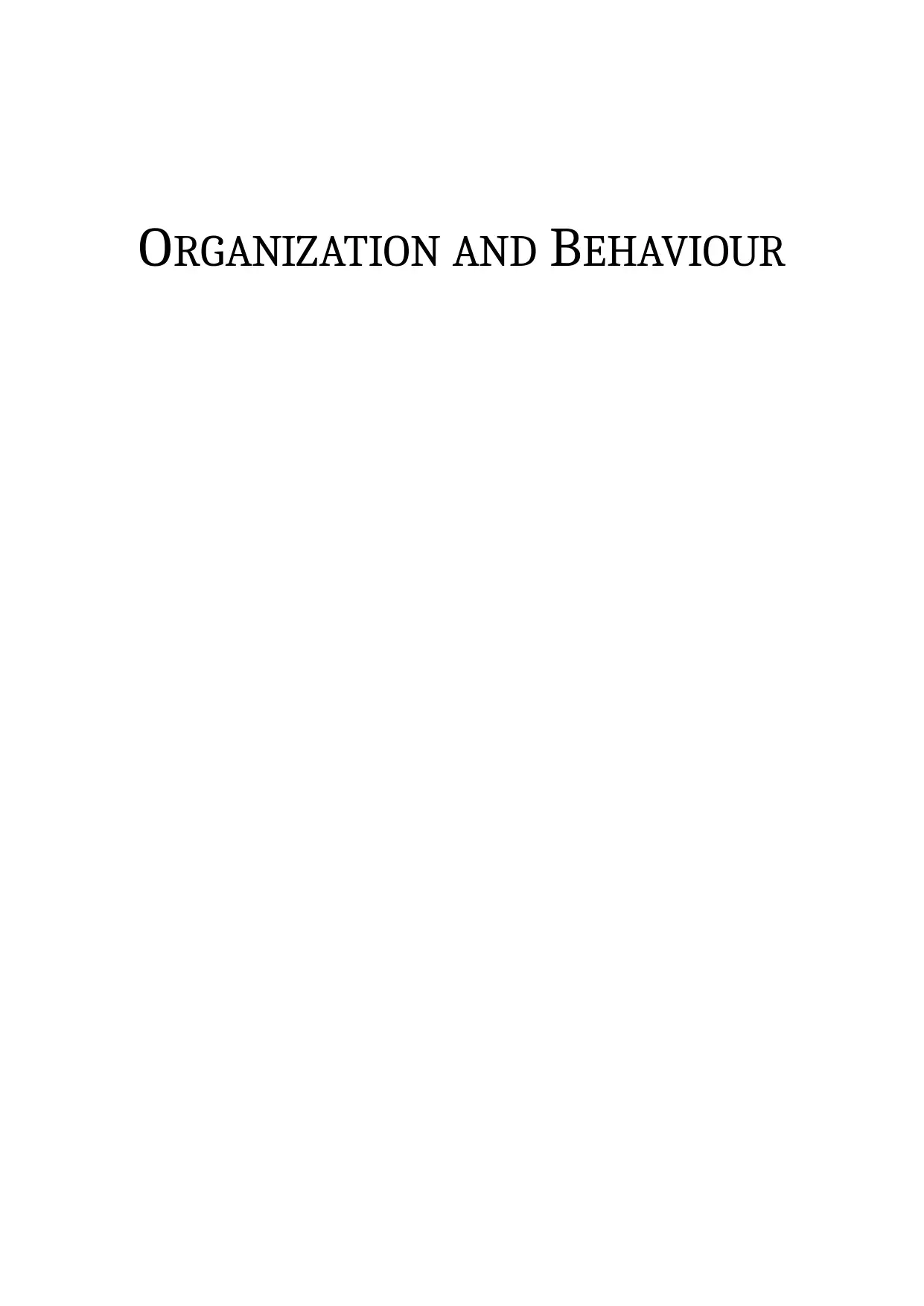
ORGANIZATION AND BEHAVIOUR
Secure Best Marks with AI Grader
Need help grading? Try our AI Grader for instant feedback on your assignments.
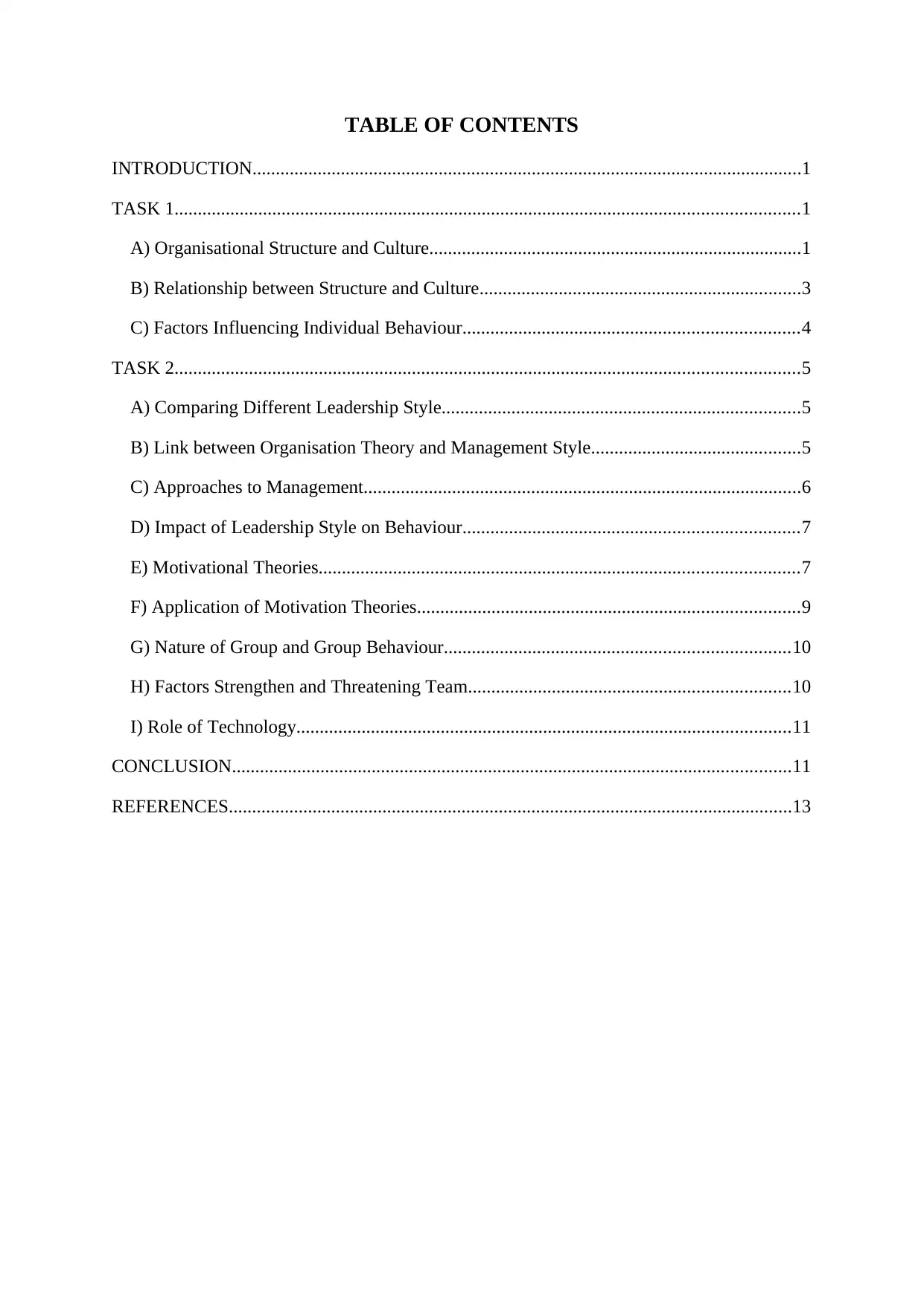
TABLE OF CONTENTS
INTRODUCTION......................................................................................................................1
TASK 1......................................................................................................................................1
A) Organisational Structure and Culture................................................................................1
B) Relationship between Structure and Culture.....................................................................3
C) Factors Influencing Individual Behaviour........................................................................4
TASK 2......................................................................................................................................5
A) Comparing Different Leadership Style.............................................................................5
B) Link between Organisation Theory and Management Style.............................................5
C) Approaches to Management..............................................................................................6
D) Impact of Leadership Style on Behaviour........................................................................7
E) Motivational Theories.......................................................................................................7
F) Application of Motivation Theories..................................................................................9
G) Nature of Group and Group Behaviour..........................................................................10
H) Factors Strengthen and Threatening Team.....................................................................10
I) Role of Technology..........................................................................................................11
CONCLUSION........................................................................................................................11
REFERENCES.........................................................................................................................13
INTRODUCTION......................................................................................................................1
TASK 1......................................................................................................................................1
A) Organisational Structure and Culture................................................................................1
B) Relationship between Structure and Culture.....................................................................3
C) Factors Influencing Individual Behaviour........................................................................4
TASK 2......................................................................................................................................5
A) Comparing Different Leadership Style.............................................................................5
B) Link between Organisation Theory and Management Style.............................................5
C) Approaches to Management..............................................................................................6
D) Impact of Leadership Style on Behaviour........................................................................7
E) Motivational Theories.......................................................................................................7
F) Application of Motivation Theories..................................................................................9
G) Nature of Group and Group Behaviour..........................................................................10
H) Factors Strengthen and Threatening Team.....................................................................10
I) Role of Technology..........................................................................................................11
CONCLUSION........................................................................................................................11
REFERENCES.........................................................................................................................13

LIST OF FIGURES
Figure 1: Tall Structure..............................................................................................................1
Figure 2: Flat Structure..............................................................................................................2
Figure 3: Organization Culture..................................................................................................3
Figure 4: Maslow’s Need Hierarchy Theory.............................................................................8
Figure 5: McGregor’s Theory X and Y......................................................................................9
Figure 1: Tall Structure..............................................................................................................1
Figure 2: Flat Structure..............................................................................................................2
Figure 3: Organization Culture..................................................................................................3
Figure 4: Maslow’s Need Hierarchy Theory.............................................................................8
Figure 5: McGregor’s Theory X and Y......................................................................................9
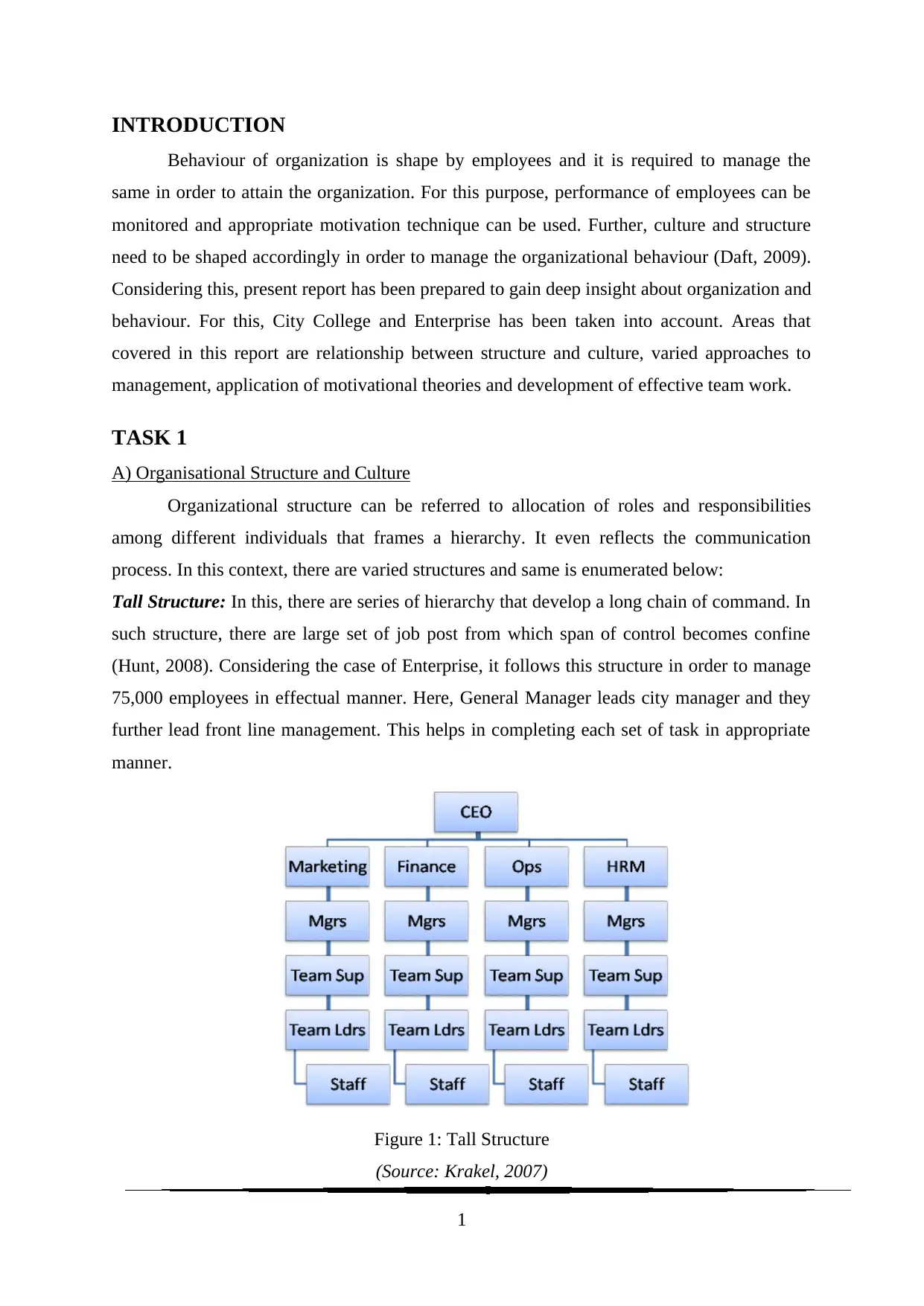
INTRODUCTION
Behaviour of organization is shape by employees and it is required to manage the
same in order to attain the organization. For this purpose, performance of employees can be
monitored and appropriate motivation technique can be used. Further, culture and structure
need to be shaped accordingly in order to manage the organizational behaviour (Daft, 2009).
Considering this, present report has been prepared to gain deep insight about organization and
behaviour. For this, City College and Enterprise has been taken into account. Areas that
covered in this report are relationship between structure and culture, varied approaches to
management, application of motivational theories and development of effective team work.
TASK 1
A) Organisational Structure and Culture
Organizational structure can be referred to allocation of roles and responsibilities
among different individuals that frames a hierarchy. It even reflects the communication
process. In this context, there are varied structures and same is enumerated below:
Tall Structure: In this, there are series of hierarchy that develop a long chain of command. In
such structure, there are large set of job post from which span of control becomes confine
(Hunt, 2008). Considering the case of Enterprise, it follows this structure in order to manage
75,000 employees in effectual manner. Here, General Manager leads city manager and they
further lead front line management. This helps in completing each set of task in appropriate
manner.
Figure 1: Tall Structure
(Source: Krakel, 2007)
1
Behaviour of organization is shape by employees and it is required to manage the
same in order to attain the organization. For this purpose, performance of employees can be
monitored and appropriate motivation technique can be used. Further, culture and structure
need to be shaped accordingly in order to manage the organizational behaviour (Daft, 2009).
Considering this, present report has been prepared to gain deep insight about organization and
behaviour. For this, City College and Enterprise has been taken into account. Areas that
covered in this report are relationship between structure and culture, varied approaches to
management, application of motivational theories and development of effective team work.
TASK 1
A) Organisational Structure and Culture
Organizational structure can be referred to allocation of roles and responsibilities
among different individuals that frames a hierarchy. It even reflects the communication
process. In this context, there are varied structures and same is enumerated below:
Tall Structure: In this, there are series of hierarchy that develop a long chain of command. In
such structure, there are large set of job post from which span of control becomes confine
(Hunt, 2008). Considering the case of Enterprise, it follows this structure in order to manage
75,000 employees in effectual manner. Here, General Manager leads city manager and they
further lead front line management. This helps in completing each set of task in appropriate
manner.
Figure 1: Tall Structure
(Source: Krakel, 2007)
1
Secure Best Marks with AI Grader
Need help grading? Try our AI Grader for instant feedback on your assignments.
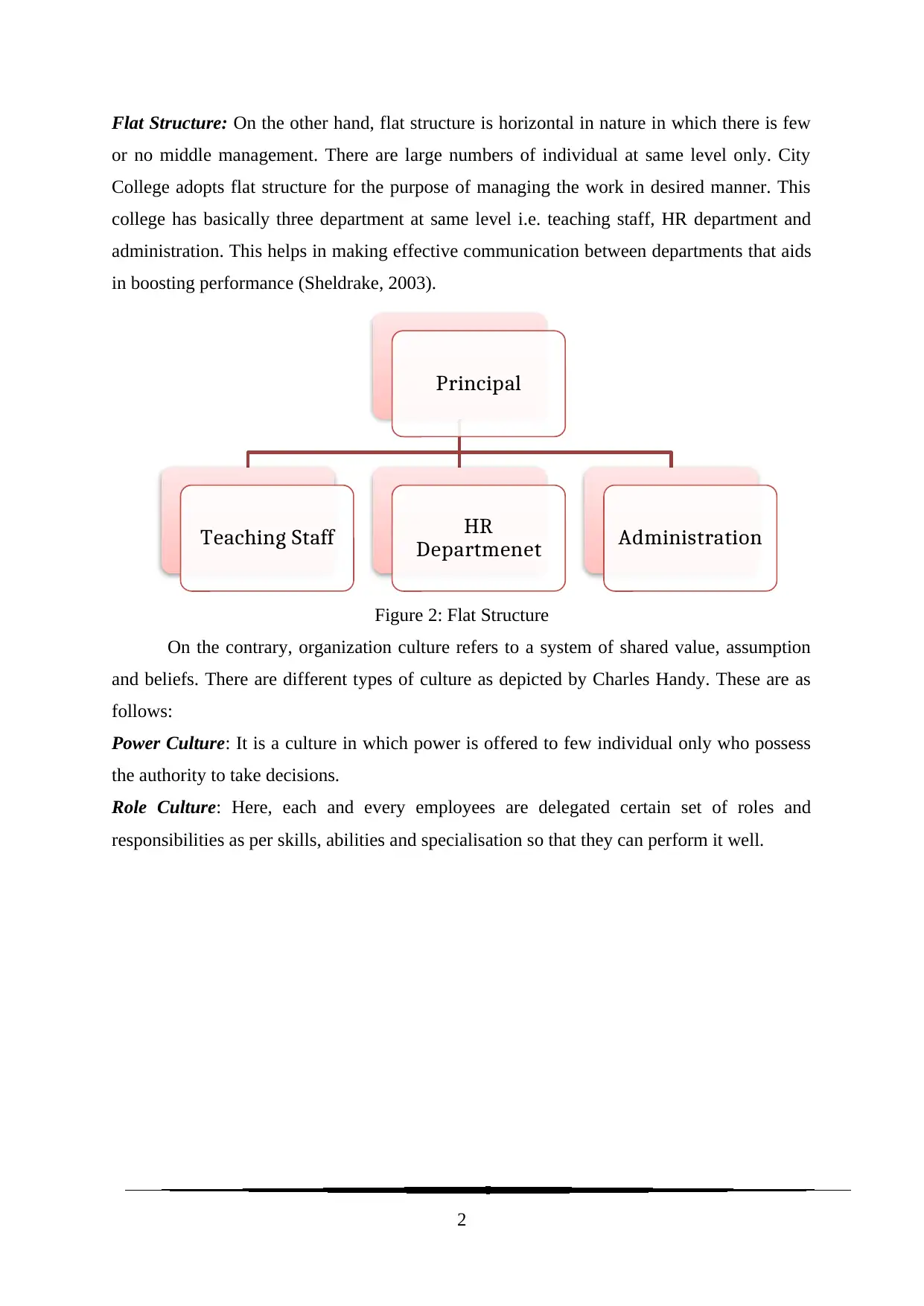
Flat Structure: On the other hand, flat structure is horizontal in nature in which there is few
or no middle management. There are large numbers of individual at same level only. City
College adopts flat structure for the purpose of managing the work in desired manner. This
college has basically three department at same level i.e. teaching staff, HR department and
administration. This helps in making effective communication between departments that aids
in boosting performance (Sheldrake, 2003).
Figure 2: Flat Structure
On the contrary, organization culture refers to a system of shared value, assumption
and beliefs. There are different types of culture as depicted by Charles Handy. These are as
follows:
Power Culture: It is a culture in which power is offered to few individual only who possess
the authority to take decisions.
Role Culture: Here, each and every employees are delegated certain set of roles and
responsibilities as per skills, abilities and specialisation so that they can perform it well.
2
Principal
Teaching Staff HR
Departmenet Administration
or no middle management. There are large numbers of individual at same level only. City
College adopts flat structure for the purpose of managing the work in desired manner. This
college has basically three department at same level i.e. teaching staff, HR department and
administration. This helps in making effective communication between departments that aids
in boosting performance (Sheldrake, 2003).
Figure 2: Flat Structure
On the contrary, organization culture refers to a system of shared value, assumption
and beliefs. There are different types of culture as depicted by Charles Handy. These are as
follows:
Power Culture: It is a culture in which power is offered to few individual only who possess
the authority to take decisions.
Role Culture: Here, each and every employees are delegated certain set of roles and
responsibilities as per skills, abilities and specialisation so that they can perform it well.
2
Principal
Teaching Staff HR
Departmenet Administration
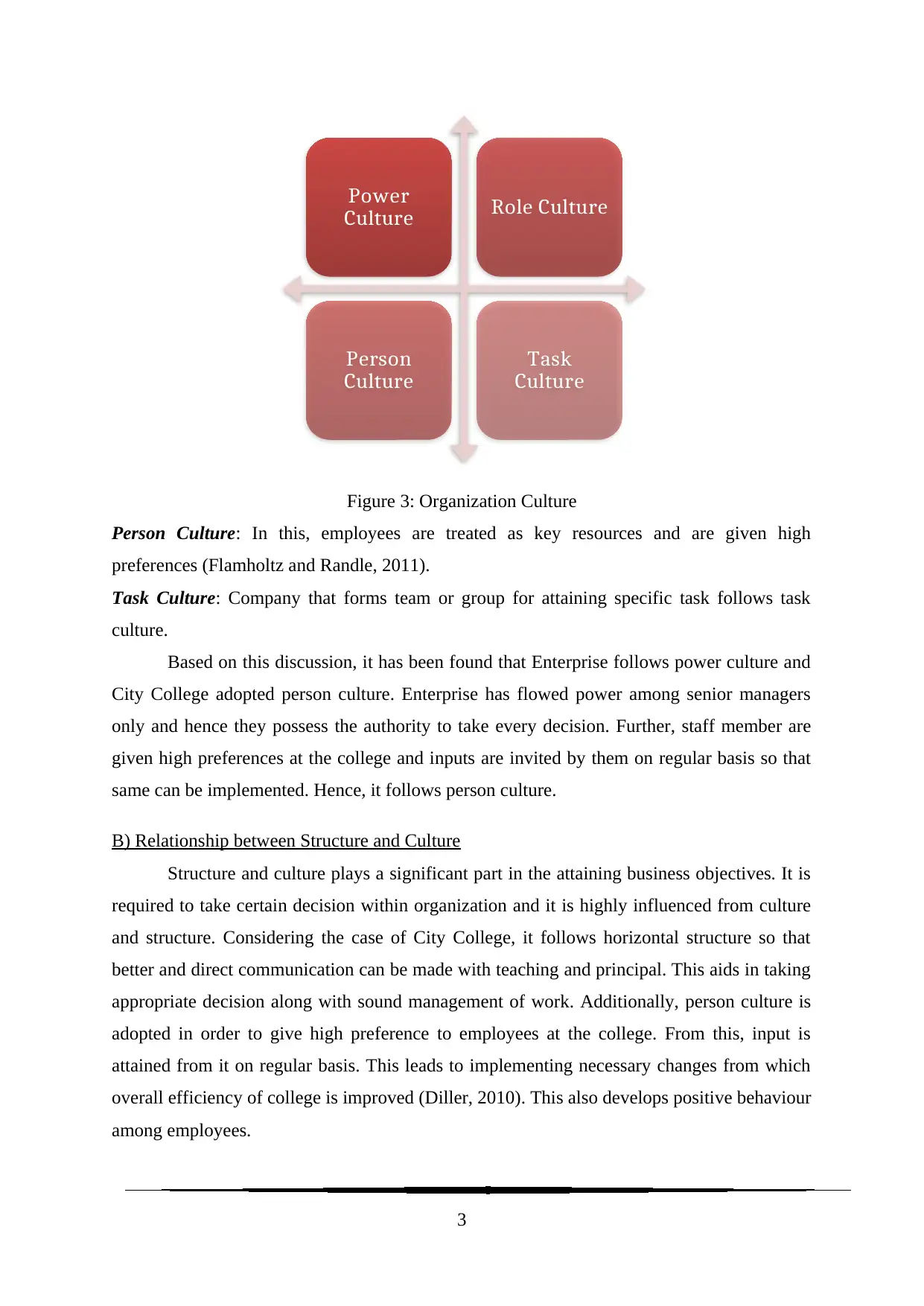
Figure 3: Organization Culture
Person Culture: In this, employees are treated as key resources and are given high
preferences (Flamholtz and Randle, 2011).
Task Culture: Company that forms team or group for attaining specific task follows task
culture.
Based on this discussion, it has been found that Enterprise follows power culture and
City College adopted person culture. Enterprise has flowed power among senior managers
only and hence they possess the authority to take every decision. Further, staff member are
given high preferences at the college and inputs are invited by them on regular basis so that
same can be implemented. Hence, it follows person culture.
B) Relationship between Structure and Culture
Structure and culture plays a significant part in the attaining business objectives. It is
required to take certain decision within organization and it is highly influenced from culture
and structure. Considering the case of City College, it follows horizontal structure so that
better and direct communication can be made with teaching and principal. This aids in taking
appropriate decision along with sound management of work. Additionally, person culture is
adopted in order to give high preference to employees at the college. From this, input is
attained from it on regular basis. This leads to implementing necessary changes from which
overall efficiency of college is improved (Diller, 2010). This also develops positive behaviour
among employees.
3
Power
Culture Role Culture
Person
Culture
Task
Culture
Person Culture: In this, employees are treated as key resources and are given high
preferences (Flamholtz and Randle, 2011).
Task Culture: Company that forms team or group for attaining specific task follows task
culture.
Based on this discussion, it has been found that Enterprise follows power culture and
City College adopted person culture. Enterprise has flowed power among senior managers
only and hence they possess the authority to take every decision. Further, staff member are
given high preferences at the college and inputs are invited by them on regular basis so that
same can be implemented. Hence, it follows person culture.
B) Relationship between Structure and Culture
Structure and culture plays a significant part in the attaining business objectives. It is
required to take certain decision within organization and it is highly influenced from culture
and structure. Considering the case of City College, it follows horizontal structure so that
better and direct communication can be made with teaching and principal. This aids in taking
appropriate decision along with sound management of work. Additionally, person culture is
adopted in order to give high preference to employees at the college. From this, input is
attained from it on regular basis. This leads to implementing necessary changes from which
overall efficiency of college is improved (Diller, 2010). This also develops positive behaviour
among employees.
3
Power
Culture Role Culture
Person
Culture
Task
Culture
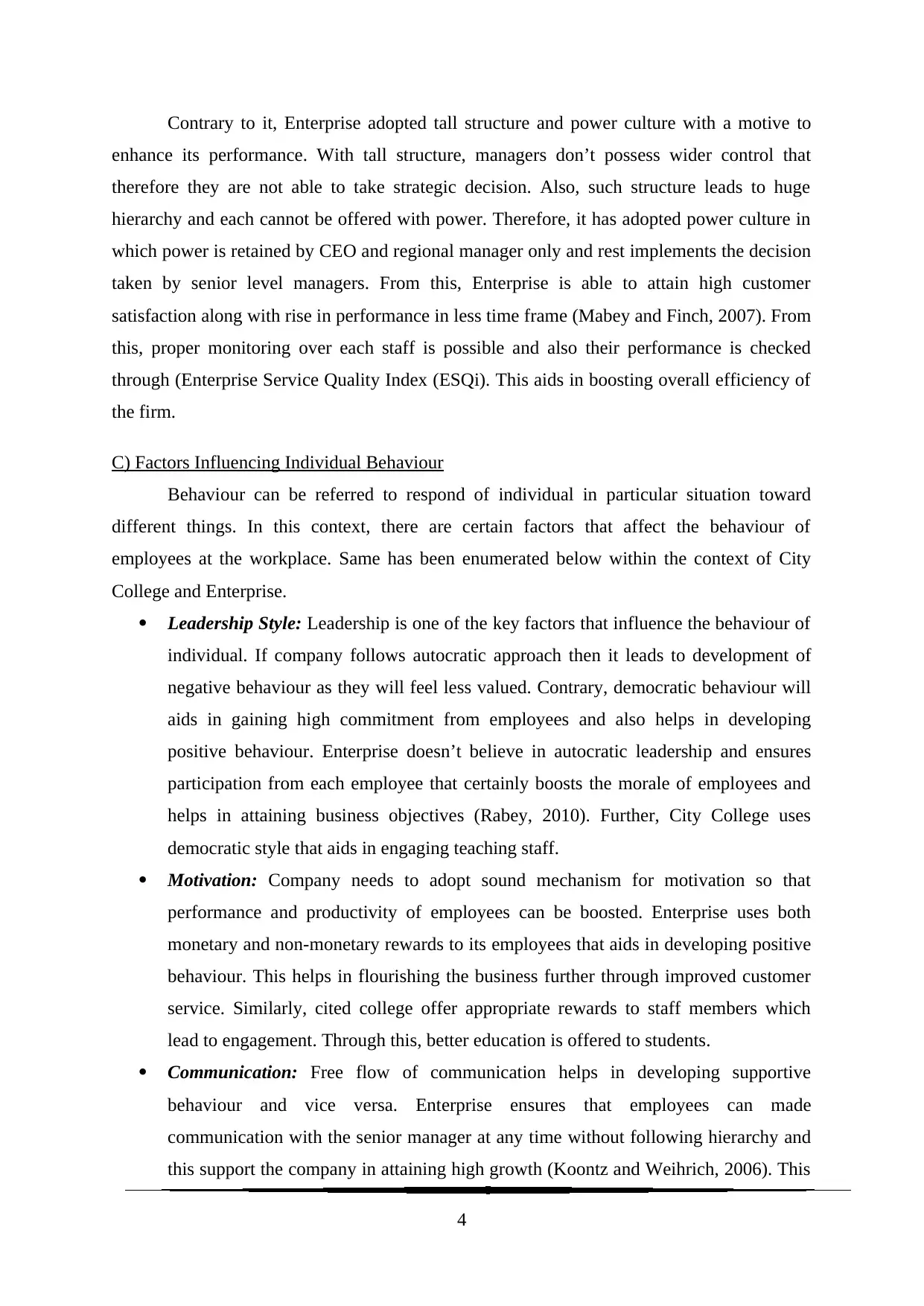
Contrary to it, Enterprise adopted tall structure and power culture with a motive to
enhance its performance. With tall structure, managers don’t possess wider control that
therefore they are not able to take strategic decision. Also, such structure leads to huge
hierarchy and each cannot be offered with power. Therefore, it has adopted power culture in
which power is retained by CEO and regional manager only and rest implements the decision
taken by senior level managers. From this, Enterprise is able to attain high customer
satisfaction along with rise in performance in less time frame (Mabey and Finch, 2007). From
this, proper monitoring over each staff is possible and also their performance is checked
through (Enterprise Service Quality Index (ESQi). This aids in boosting overall efficiency of
the firm.
C) Factors Influencing Individual Behaviour
Behaviour can be referred to respond of individual in particular situation toward
different things. In this context, there are certain factors that affect the behaviour of
employees at the workplace. Same has been enumerated below within the context of City
College and Enterprise.
Leadership Style: Leadership is one of the key factors that influence the behaviour of
individual. If company follows autocratic approach then it leads to development of
negative behaviour as they will feel less valued. Contrary, democratic behaviour will
aids in gaining high commitment from employees and also helps in developing
positive behaviour. Enterprise doesn’t believe in autocratic leadership and ensures
participation from each employee that certainly boosts the morale of employees and
helps in attaining business objectives (Rabey, 2010). Further, City College uses
democratic style that aids in engaging teaching staff.
Motivation: Company needs to adopt sound mechanism for motivation so that
performance and productivity of employees can be boosted. Enterprise uses both
monetary and non-monetary rewards to its employees that aids in developing positive
behaviour. This helps in flourishing the business further through improved customer
service. Similarly, cited college offer appropriate rewards to staff members which
lead to engagement. Through this, better education is offered to students.
Communication: Free flow of communication helps in developing supportive
behaviour and vice versa. Enterprise ensures that employees can made
communication with the senior manager at any time without following hierarchy and
this support the company in attaining high growth (Koontz and Weihrich, 2006). This
4
enhance its performance. With tall structure, managers don’t possess wider control that
therefore they are not able to take strategic decision. Also, such structure leads to huge
hierarchy and each cannot be offered with power. Therefore, it has adopted power culture in
which power is retained by CEO and regional manager only and rest implements the decision
taken by senior level managers. From this, Enterprise is able to attain high customer
satisfaction along with rise in performance in less time frame (Mabey and Finch, 2007). From
this, proper monitoring over each staff is possible and also their performance is checked
through (Enterprise Service Quality Index (ESQi). This aids in boosting overall efficiency of
the firm.
C) Factors Influencing Individual Behaviour
Behaviour can be referred to respond of individual in particular situation toward
different things. In this context, there are certain factors that affect the behaviour of
employees at the workplace. Same has been enumerated below within the context of City
College and Enterprise.
Leadership Style: Leadership is one of the key factors that influence the behaviour of
individual. If company follows autocratic approach then it leads to development of
negative behaviour as they will feel less valued. Contrary, democratic behaviour will
aids in gaining high commitment from employees and also helps in developing
positive behaviour. Enterprise doesn’t believe in autocratic leadership and ensures
participation from each employee that certainly boosts the morale of employees and
helps in attaining business objectives (Rabey, 2010). Further, City College uses
democratic style that aids in engaging teaching staff.
Motivation: Company needs to adopt sound mechanism for motivation so that
performance and productivity of employees can be boosted. Enterprise uses both
monetary and non-monetary rewards to its employees that aids in developing positive
behaviour. This helps in flourishing the business further through improved customer
service. Similarly, cited college offer appropriate rewards to staff members which
lead to engagement. Through this, better education is offered to students.
Communication: Free flow of communication helps in developing supportive
behaviour and vice versa. Enterprise ensures that employees can made
communication with the senior manager at any time without following hierarchy and
this support the company in attaining high growth (Koontz and Weihrich, 2006). This
4
Paraphrase This Document
Need a fresh take? Get an instant paraphrase of this document with our AI Paraphraser

helps in offering better service to clients. Further, HR department of College focuses
on developing healthy relation with workforce through proper commutation that aids
in developing sound strategies which helps in attaining objectives.
TASK 2
A) Comparing Different Leadership Style
There are varied set of leadership style that been applied in organization at different
level in order to accomplish the business objectives. In this context, following are varied
leadership style along with its impact on both organizations:
o Authoritarian Style: It is a style in which leaders keep close control over the
employees and adopts strict behaviour towards adhering with policy. In this, leaders
take decision on its own without involving any subordinates. From this style, staff of
City College will feel less valued and it will certainly decline their motivation level.
From this, ratio retention will also affect as workforce will leave the job. This is so
because staffs of college are professors which is highly intellectual and authoritative
style will affect their morale (Hua and Lu, 2013). Similarly, employees at Enterprise
will be working with fear and it tends to make negative impact on customer service as
well. However, this style is effective in taking quick decisions.
o Democratic Style: It is a style in which leaders invites subordinates for decision
making activity and share each and everything with employees. It aids in developing
healthier relations with employees that tends to increase the coordination level. Both
organizations i.e. City College and Enterprise follow this style in order to gain
valuable inputs from employees. This helps in implementing the suggestion
throughout the organization from which value is added (Eisele and et.al., 2013).
Democratic style even helps in attaining the objectives in desired manner.
o Laissez Faire: In this style, leader doesn’t play any role in decision making or make
interaction with employees. If this style is adopted in Enterprise then it certainly
spoils its performance as employees will not be getting any support from senior
managers. However, this style will aids staff of cited college to take decision on its
own from which there morale will get increased (Klein, 2011).
B) Link between Organisation Theory and Management Style
Organization theory involves managing and monitoring personnel with a motive to
boost effectives of the company. With the help of it, manager is able to manage the business
5
on developing healthy relation with workforce through proper commutation that aids
in developing sound strategies which helps in attaining objectives.
TASK 2
A) Comparing Different Leadership Style
There are varied set of leadership style that been applied in organization at different
level in order to accomplish the business objectives. In this context, following are varied
leadership style along with its impact on both organizations:
o Authoritarian Style: It is a style in which leaders keep close control over the
employees and adopts strict behaviour towards adhering with policy. In this, leaders
take decision on its own without involving any subordinates. From this style, staff of
City College will feel less valued and it will certainly decline their motivation level.
From this, ratio retention will also affect as workforce will leave the job. This is so
because staffs of college are professors which is highly intellectual and authoritative
style will affect their morale (Hua and Lu, 2013). Similarly, employees at Enterprise
will be working with fear and it tends to make negative impact on customer service as
well. However, this style is effective in taking quick decisions.
o Democratic Style: It is a style in which leaders invites subordinates for decision
making activity and share each and everything with employees. It aids in developing
healthier relations with employees that tends to increase the coordination level. Both
organizations i.e. City College and Enterprise follow this style in order to gain
valuable inputs from employees. This helps in implementing the suggestion
throughout the organization from which value is added (Eisele and et.al., 2013).
Democratic style even helps in attaining the objectives in desired manner.
o Laissez Faire: In this style, leader doesn’t play any role in decision making or make
interaction with employees. If this style is adopted in Enterprise then it certainly
spoils its performance as employees will not be getting any support from senior
managers. However, this style will aids staff of cited college to take decision on its
own from which there morale will get increased (Klein, 2011).
B) Link between Organisation Theory and Management Style
Organization theory involves managing and monitoring personnel with a motive to
boost effectives of the company. With the help of it, manager is able to manage the business
5
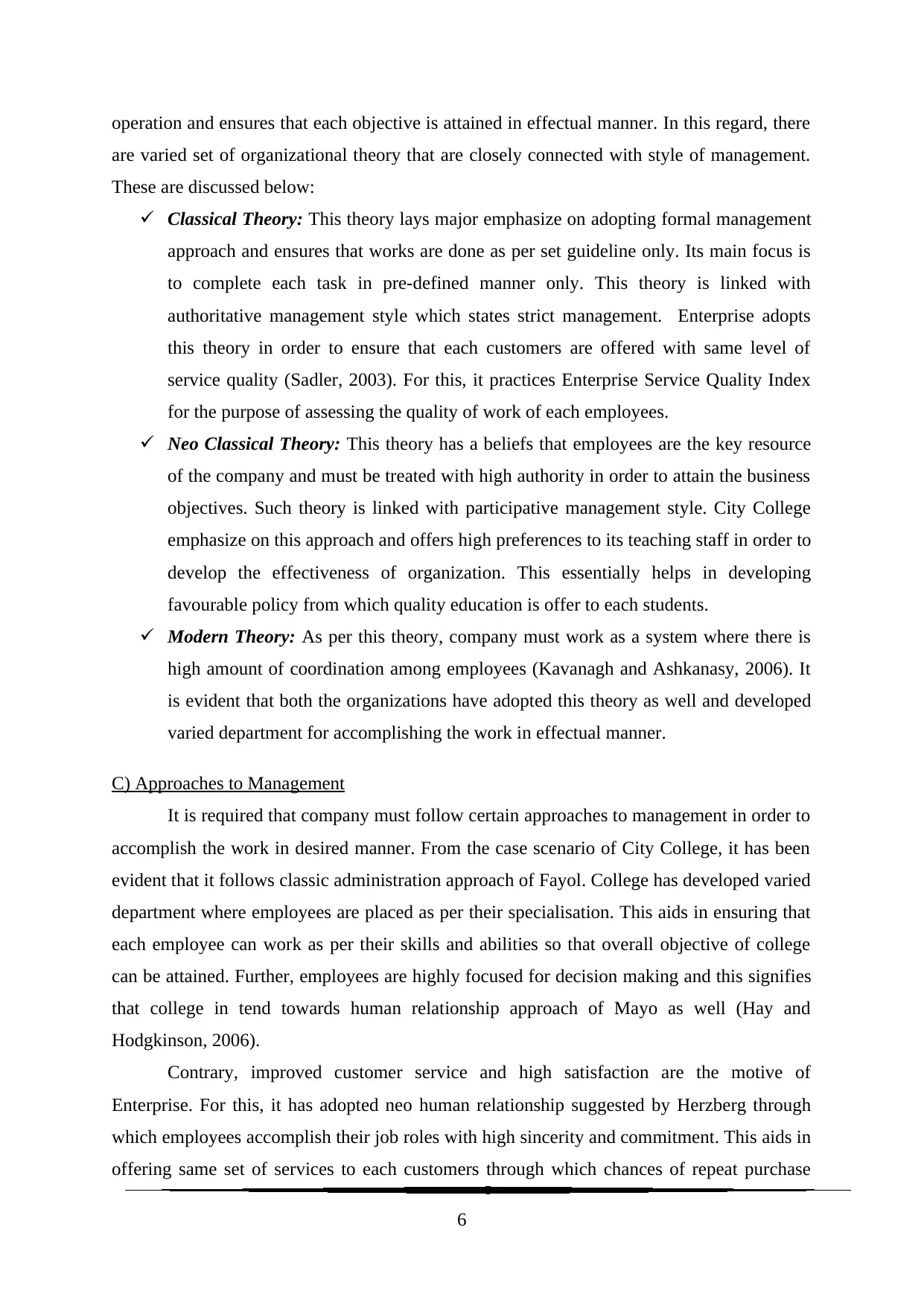
operation and ensures that each objective is attained in effectual manner. In this regard, there
are varied set of organizational theory that are closely connected with style of management.
These are discussed below:
Classical Theory: This theory lays major emphasize on adopting formal management
approach and ensures that works are done as per set guideline only. Its main focus is
to complete each task in pre-defined manner only. This theory is linked with
authoritative management style which states strict management. Enterprise adopts
this theory in order to ensure that each customers are offered with same level of
service quality (Sadler, 2003). For this, it practices Enterprise Service Quality Index
for the purpose of assessing the quality of work of each employees.
Neo Classical Theory: This theory has a beliefs that employees are the key resource
of the company and must be treated with high authority in order to attain the business
objectives. Such theory is linked with participative management style. City College
emphasize on this approach and offers high preferences to its teaching staff in order to
develop the effectiveness of organization. This essentially helps in developing
favourable policy from which quality education is offer to each students.
Modern Theory: As per this theory, company must work as a system where there is
high amount of coordination among employees (Kavanagh and Ashkanasy, 2006). It
is evident that both the organizations have adopted this theory as well and developed
varied department for accomplishing the work in effectual manner.
C) Approaches to Management
It is required that company must follow certain approaches to management in order to
accomplish the work in desired manner. From the case scenario of City College, it has been
evident that it follows classic administration approach of Fayol. College has developed varied
department where employees are placed as per their specialisation. This aids in ensuring that
each employee can work as per their skills and abilities so that overall objective of college
can be attained. Further, employees are highly focused for decision making and this signifies
that college in tend towards human relationship approach of Mayo as well (Hay and
Hodgkinson, 2006).
Contrary, improved customer service and high satisfaction are the motive of
Enterprise. For this, it has adopted neo human relationship suggested by Herzberg through
which employees accomplish their job roles with high sincerity and commitment. This aids in
offering same set of services to each customers through which chances of repeat purchase
6
are varied set of organizational theory that are closely connected with style of management.
These are discussed below:
Classical Theory: This theory lays major emphasize on adopting formal management
approach and ensures that works are done as per set guideline only. Its main focus is
to complete each task in pre-defined manner only. This theory is linked with
authoritative management style which states strict management. Enterprise adopts
this theory in order to ensure that each customers are offered with same level of
service quality (Sadler, 2003). For this, it practices Enterprise Service Quality Index
for the purpose of assessing the quality of work of each employees.
Neo Classical Theory: This theory has a beliefs that employees are the key resource
of the company and must be treated with high authority in order to attain the business
objectives. Such theory is linked with participative management style. City College
emphasize on this approach and offers high preferences to its teaching staff in order to
develop the effectiveness of organization. This essentially helps in developing
favourable policy from which quality education is offer to each students.
Modern Theory: As per this theory, company must work as a system where there is
high amount of coordination among employees (Kavanagh and Ashkanasy, 2006). It
is evident that both the organizations have adopted this theory as well and developed
varied department for accomplishing the work in effectual manner.
C) Approaches to Management
It is required that company must follow certain approaches to management in order to
accomplish the work in desired manner. From the case scenario of City College, it has been
evident that it follows classic administration approach of Fayol. College has developed varied
department where employees are placed as per their specialisation. This aids in ensuring that
each employee can work as per their skills and abilities so that overall objective of college
can be attained. Further, employees are highly focused for decision making and this signifies
that college in tend towards human relationship approach of Mayo as well (Hay and
Hodgkinson, 2006).
Contrary, improved customer service and high satisfaction are the motive of
Enterprise. For this, it has adopted neo human relationship suggested by Herzberg through
which employees accomplish their job roles with high sincerity and commitment. This aids in
offering same set of services to each customers through which chances of repeat purchase
6
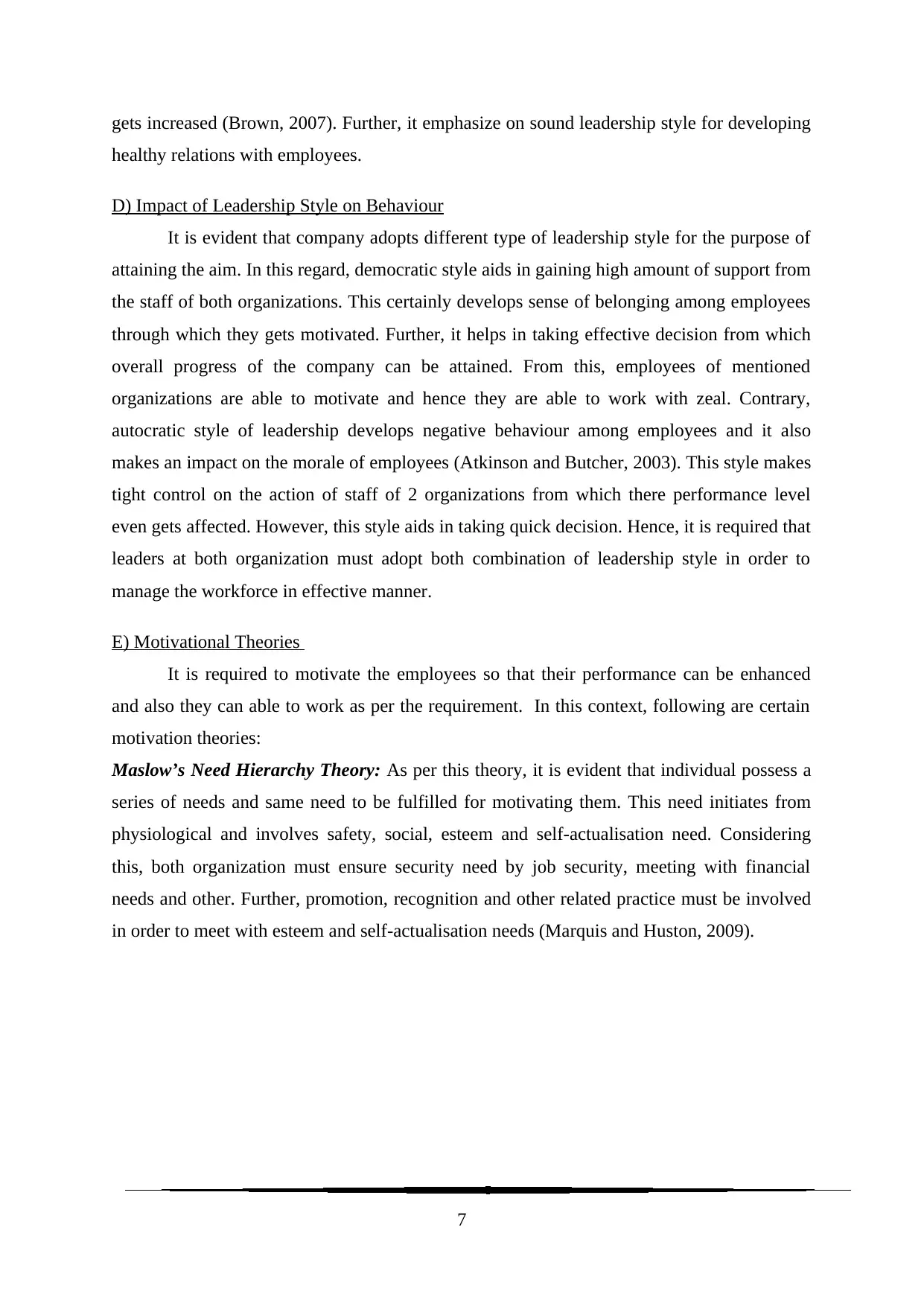
gets increased (Brown, 2007). Further, it emphasize on sound leadership style for developing
healthy relations with employees.
D) Impact of Leadership Style on Behaviour
It is evident that company adopts different type of leadership style for the purpose of
attaining the aim. In this regard, democratic style aids in gaining high amount of support from
the staff of both organizations. This certainly develops sense of belonging among employees
through which they gets motivated. Further, it helps in taking effective decision from which
overall progress of the company can be attained. From this, employees of mentioned
organizations are able to motivate and hence they are able to work with zeal. Contrary,
autocratic style of leadership develops negative behaviour among employees and it also
makes an impact on the morale of employees (Atkinson and Butcher, 2003). This style makes
tight control on the action of staff of 2 organizations from which there performance level
even gets affected. However, this style aids in taking quick decision. Hence, it is required that
leaders at both organization must adopt both combination of leadership style in order to
manage the workforce in effective manner.
E) Motivational Theories
It is required to motivate the employees so that their performance can be enhanced
and also they can able to work as per the requirement. In this context, following are certain
motivation theories:
Maslow’s Need Hierarchy Theory: As per this theory, it is evident that individual possess a
series of needs and same need to be fulfilled for motivating them. This need initiates from
physiological and involves safety, social, esteem and self-actualisation need. Considering
this, both organization must ensure security need by job security, meeting with financial
needs and other. Further, promotion, recognition and other related practice must be involved
in order to meet with esteem and self-actualisation needs (Marquis and Huston, 2009).
7
healthy relations with employees.
D) Impact of Leadership Style on Behaviour
It is evident that company adopts different type of leadership style for the purpose of
attaining the aim. In this regard, democratic style aids in gaining high amount of support from
the staff of both organizations. This certainly develops sense of belonging among employees
through which they gets motivated. Further, it helps in taking effective decision from which
overall progress of the company can be attained. From this, employees of mentioned
organizations are able to motivate and hence they are able to work with zeal. Contrary,
autocratic style of leadership develops negative behaviour among employees and it also
makes an impact on the morale of employees (Atkinson and Butcher, 2003). This style makes
tight control on the action of staff of 2 organizations from which there performance level
even gets affected. However, this style aids in taking quick decision. Hence, it is required that
leaders at both organization must adopt both combination of leadership style in order to
manage the workforce in effective manner.
E) Motivational Theories
It is required to motivate the employees so that their performance can be enhanced
and also they can able to work as per the requirement. In this context, following are certain
motivation theories:
Maslow’s Need Hierarchy Theory: As per this theory, it is evident that individual possess a
series of needs and same need to be fulfilled for motivating them. This need initiates from
physiological and involves safety, social, esteem and self-actualisation need. Considering
this, both organization must ensure security need by job security, meeting with financial
needs and other. Further, promotion, recognition and other related practice must be involved
in order to meet with esteem and self-actualisation needs (Marquis and Huston, 2009).
7
Secure Best Marks with AI Grader
Need help grading? Try our AI Grader for instant feedback on your assignments.
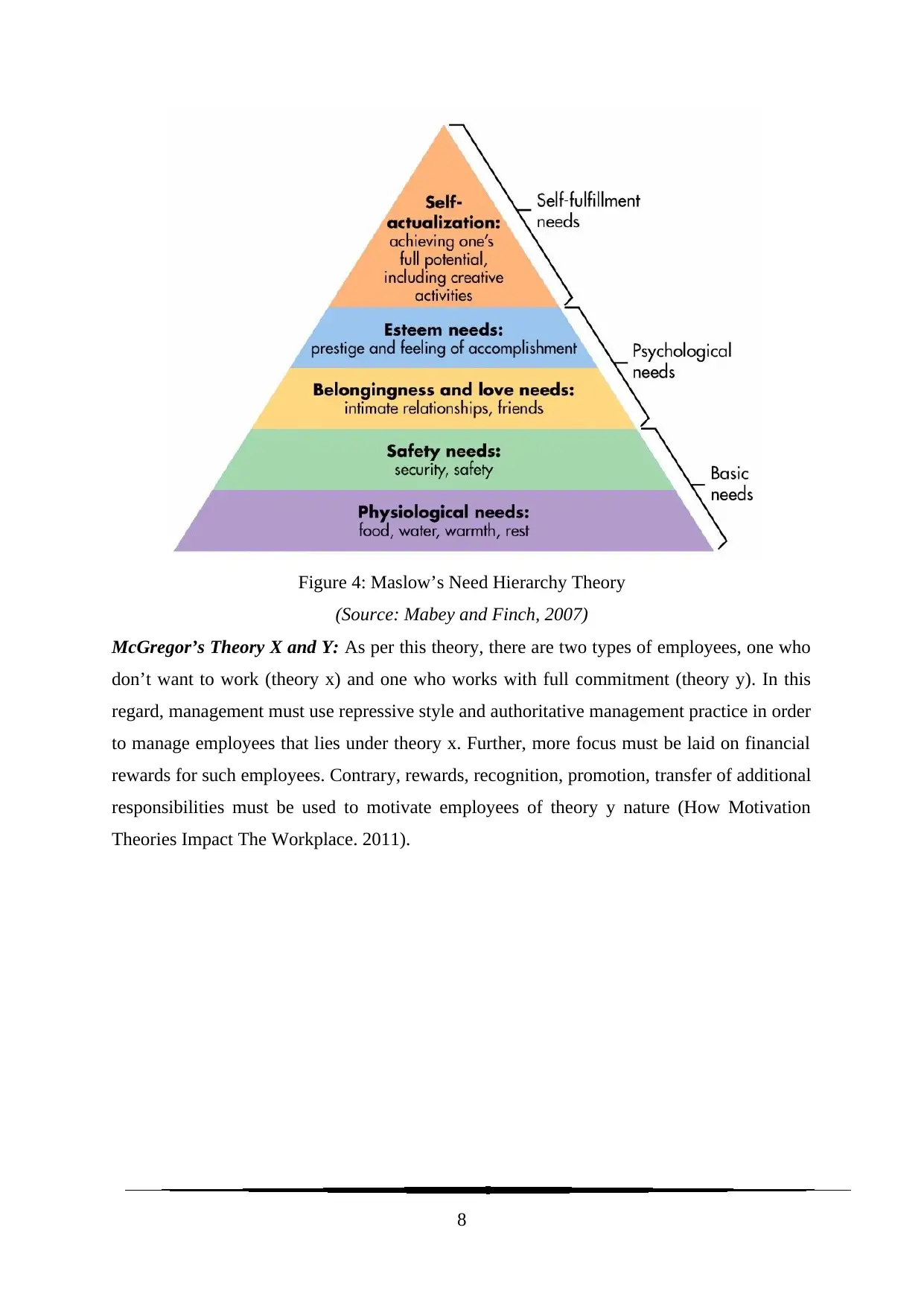
Figure 4: Maslow’s Need Hierarchy Theory
(Source: Mabey and Finch, 2007)
McGregor’s Theory X and Y: As per this theory, there are two types of employees, one who
don’t want to work (theory x) and one who works with full commitment (theory y). In this
regard, management must use repressive style and authoritative management practice in order
to manage employees that lies under theory x. Further, more focus must be laid on financial
rewards for such employees. Contrary, rewards, recognition, promotion, transfer of additional
responsibilities must be used to motivate employees of theory y nature (How Motivation
Theories Impact The Workplace. 2011).
8
(Source: Mabey and Finch, 2007)
McGregor’s Theory X and Y: As per this theory, there are two types of employees, one who
don’t want to work (theory x) and one who works with full commitment (theory y). In this
regard, management must use repressive style and authoritative management practice in order
to manage employees that lies under theory x. Further, more focus must be laid on financial
rewards for such employees. Contrary, rewards, recognition, promotion, transfer of additional
responsibilities must be used to motivate employees of theory y nature (How Motivation
Theories Impact The Workplace. 2011).
8

Figure 5: McGregor’s Theory X and Y
(Source: Bhatt, 2002)
F) Application of Motivation Theories
Motivation is key aspects for managing the performance of employees and hence it
must be done in right manner. In this context, manager at Enterprise can apply McGregor’s
theory X and Y in order to motivate employee of different nature. In this regard, employees
who don’t want to work can be motivated through reward and adopting coercive measures.
Contrary, managers can offer additional responsibilities to employees who are ready to accept
it. Further, proper recognition and reward practice must be practiced in Enterprise in order to
motivate each set of employees. This will help in gaining maximum output from employees
and even aids in attaining the objectives in desired manner. Further, City College must
focuses on component of Theory Y only and offer varied set of responsibilities among
teaching staff so that their morale can be enhanced (Densten, 2002). Also, they must be
included in decision making activity so that better coordination can be attained from it.
Apart from it, City College and Enterprise must even considered the component of
need hierarchy theory for motivating the staff. It is required that financial rewards must be
offered to lower and middle level employees for the purpose of motivating them. Contrary,
recognition, appreciation, promotion and transferring of additional responsibilities must be
9
(Source: Bhatt, 2002)
F) Application of Motivation Theories
Motivation is key aspects for managing the performance of employees and hence it
must be done in right manner. In this context, manager at Enterprise can apply McGregor’s
theory X and Y in order to motivate employee of different nature. In this regard, employees
who don’t want to work can be motivated through reward and adopting coercive measures.
Contrary, managers can offer additional responsibilities to employees who are ready to accept
it. Further, proper recognition and reward practice must be practiced in Enterprise in order to
motivate each set of employees. This will help in gaining maximum output from employees
and even aids in attaining the objectives in desired manner. Further, City College must
focuses on component of Theory Y only and offer varied set of responsibilities among
teaching staff so that their morale can be enhanced (Densten, 2002). Also, they must be
included in decision making activity so that better coordination can be attained from it.
Apart from it, City College and Enterprise must even considered the component of
need hierarchy theory for motivating the staff. It is required that financial rewards must be
offered to lower and middle level employees for the purpose of motivating them. Contrary,
recognition, appreciation, promotion and transferring of additional responsibilities must be
9
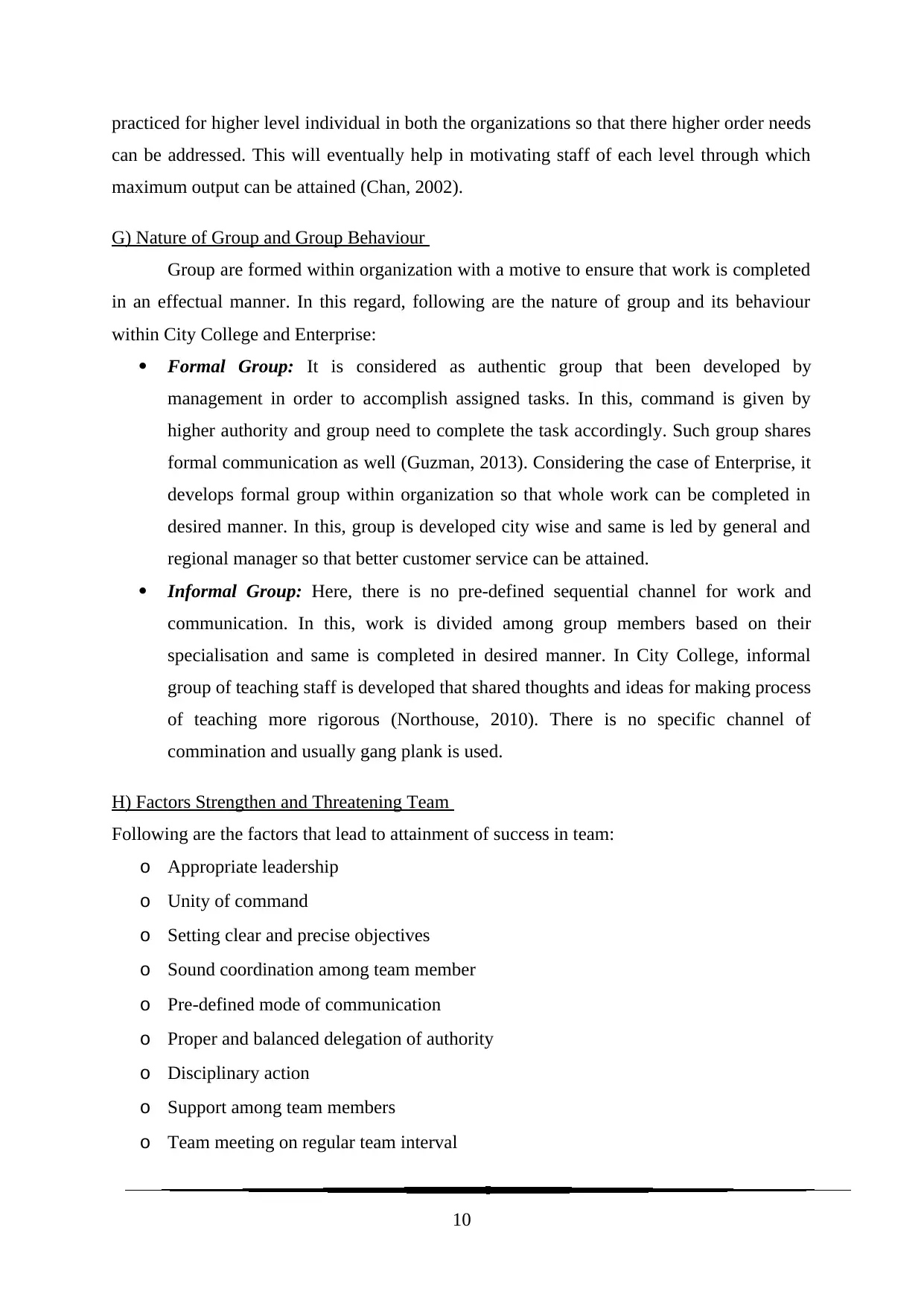
practiced for higher level individual in both the organizations so that there higher order needs
can be addressed. This will eventually help in motivating staff of each level through which
maximum output can be attained (Chan, 2002).
G) Nature of Group and Group Behaviour
Group are formed within organization with a motive to ensure that work is completed
in an effectual manner. In this regard, following are the nature of group and its behaviour
within City College and Enterprise:
Formal Group: It is considered as authentic group that been developed by
management in order to accomplish assigned tasks. In this, command is given by
higher authority and group need to complete the task accordingly. Such group shares
formal communication as well (Guzman, 2013). Considering the case of Enterprise, it
develops formal group within organization so that whole work can be completed in
desired manner. In this, group is developed city wise and same is led by general and
regional manager so that better customer service can be attained.
Informal Group: Here, there is no pre-defined sequential channel for work and
communication. In this, work is divided among group members based on their
specialisation and same is completed in desired manner. In City College, informal
group of teaching staff is developed that shared thoughts and ideas for making process
of teaching more rigorous (Northouse, 2010). There is no specific channel of
commination and usually gang plank is used.
H) Factors Strengthen and Threatening Team
Following are the factors that lead to attainment of success in team:
o Appropriate leadership
o Unity of command
o Setting clear and precise objectives
o Sound coordination among team member
o Pre-defined mode of communication
o Proper and balanced delegation of authority
o Disciplinary action
o Support among team members
o Team meeting on regular team interval
10
can be addressed. This will eventually help in motivating staff of each level through which
maximum output can be attained (Chan, 2002).
G) Nature of Group and Group Behaviour
Group are formed within organization with a motive to ensure that work is completed
in an effectual manner. In this regard, following are the nature of group and its behaviour
within City College and Enterprise:
Formal Group: It is considered as authentic group that been developed by
management in order to accomplish assigned tasks. In this, command is given by
higher authority and group need to complete the task accordingly. Such group shares
formal communication as well (Guzman, 2013). Considering the case of Enterprise, it
develops formal group within organization so that whole work can be completed in
desired manner. In this, group is developed city wise and same is led by general and
regional manager so that better customer service can be attained.
Informal Group: Here, there is no pre-defined sequential channel for work and
communication. In this, work is divided among group members based on their
specialisation and same is completed in desired manner. In City College, informal
group of teaching staff is developed that shared thoughts and ideas for making process
of teaching more rigorous (Northouse, 2010). There is no specific channel of
commination and usually gang plank is used.
H) Factors Strengthen and Threatening Team
Following are the factors that lead to attainment of success in team:
o Appropriate leadership
o Unity of command
o Setting clear and precise objectives
o Sound coordination among team member
o Pre-defined mode of communication
o Proper and balanced delegation of authority
o Disciplinary action
o Support among team members
o Team meeting on regular team interval
10
Paraphrase This Document
Need a fresh take? Get an instant paraphrase of this document with our AI Paraphraser
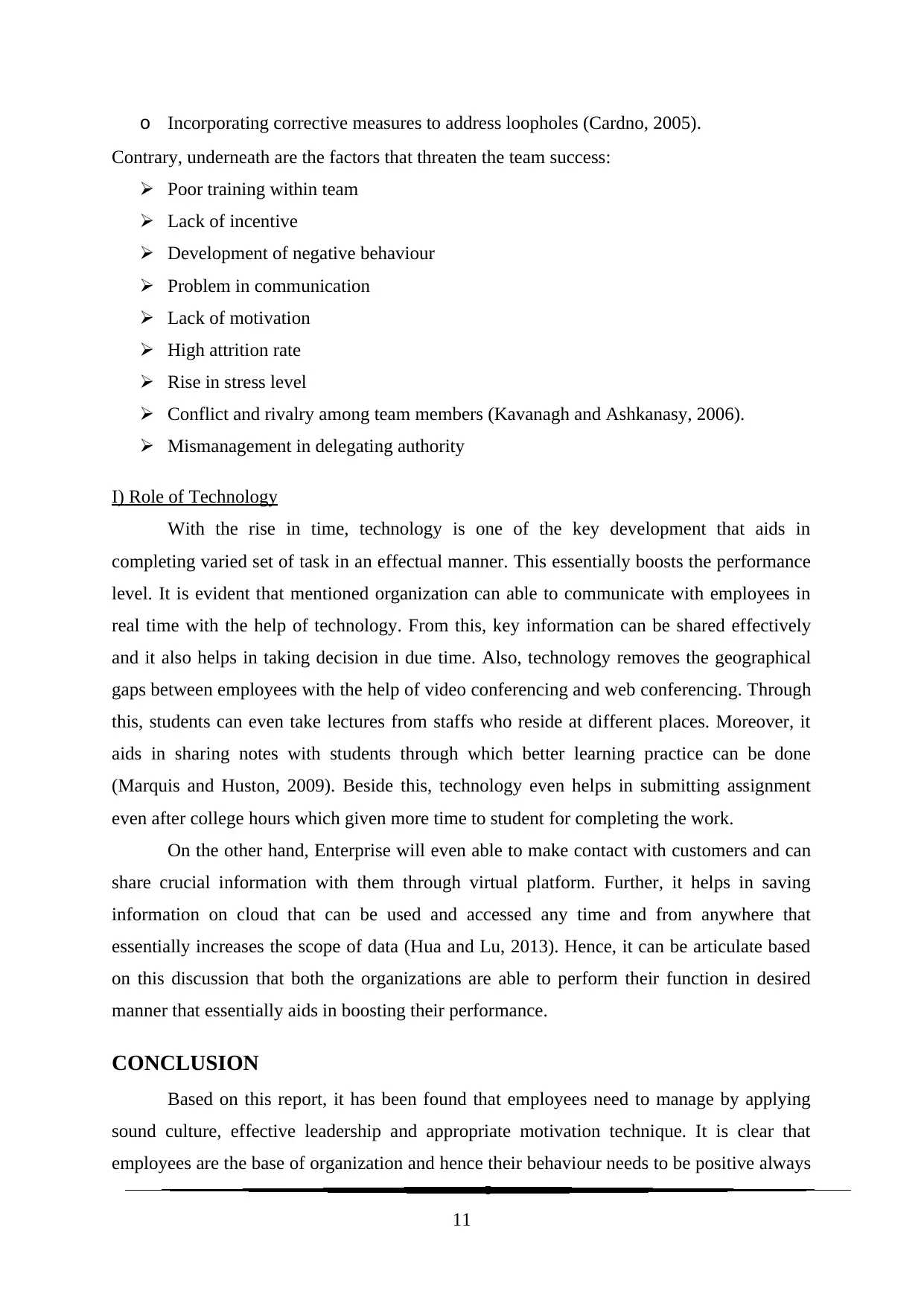
o Incorporating corrective measures to address loopholes (Cardno, 2005).
Contrary, underneath are the factors that threaten the team success:
Poor training within team
Lack of incentive
Development of negative behaviour
Problem in communication
Lack of motivation
High attrition rate
Rise in stress level
Conflict and rivalry among team members (Kavanagh and Ashkanasy, 2006).
Mismanagement in delegating authority
I) Role of Technology
With the rise in time, technology is one of the key development that aids in
completing varied set of task in an effectual manner. This essentially boosts the performance
level. It is evident that mentioned organization can able to communicate with employees in
real time with the help of technology. From this, key information can be shared effectively
and it also helps in taking decision in due time. Also, technology removes the geographical
gaps between employees with the help of video conferencing and web conferencing. Through
this, students can even take lectures from staffs who reside at different places. Moreover, it
aids in sharing notes with students through which better learning practice can be done
(Marquis and Huston, 2009). Beside this, technology even helps in submitting assignment
even after college hours which given more time to student for completing the work.
On the other hand, Enterprise will even able to make contact with customers and can
share crucial information with them through virtual platform. Further, it helps in saving
information on cloud that can be used and accessed any time and from anywhere that
essentially increases the scope of data (Hua and Lu, 2013). Hence, it can be articulate based
on this discussion that both the organizations are able to perform their function in desired
manner that essentially aids in boosting their performance.
CONCLUSION
Based on this report, it has been found that employees need to manage by applying
sound culture, effective leadership and appropriate motivation technique. It is clear that
employees are the base of organization and hence their behaviour needs to be positive always
11
Contrary, underneath are the factors that threaten the team success:
Poor training within team
Lack of incentive
Development of negative behaviour
Problem in communication
Lack of motivation
High attrition rate
Rise in stress level
Conflict and rivalry among team members (Kavanagh and Ashkanasy, 2006).
Mismanagement in delegating authority
I) Role of Technology
With the rise in time, technology is one of the key development that aids in
completing varied set of task in an effectual manner. This essentially boosts the performance
level. It is evident that mentioned organization can able to communicate with employees in
real time with the help of technology. From this, key information can be shared effectively
and it also helps in taking decision in due time. Also, technology removes the geographical
gaps between employees with the help of video conferencing and web conferencing. Through
this, students can even take lectures from staffs who reside at different places. Moreover, it
aids in sharing notes with students through which better learning practice can be done
(Marquis and Huston, 2009). Beside this, technology even helps in submitting assignment
even after college hours which given more time to student for completing the work.
On the other hand, Enterprise will even able to make contact with customers and can
share crucial information with them through virtual platform. Further, it helps in saving
information on cloud that can be used and accessed any time and from anywhere that
essentially increases the scope of data (Hua and Lu, 2013). Hence, it can be articulate based
on this discussion that both the organizations are able to perform their function in desired
manner that essentially aids in boosting their performance.
CONCLUSION
Based on this report, it has been found that employees need to manage by applying
sound culture, effective leadership and appropriate motivation technique. It is clear that
employees are the base of organization and hence their behaviour needs to be positive always
11
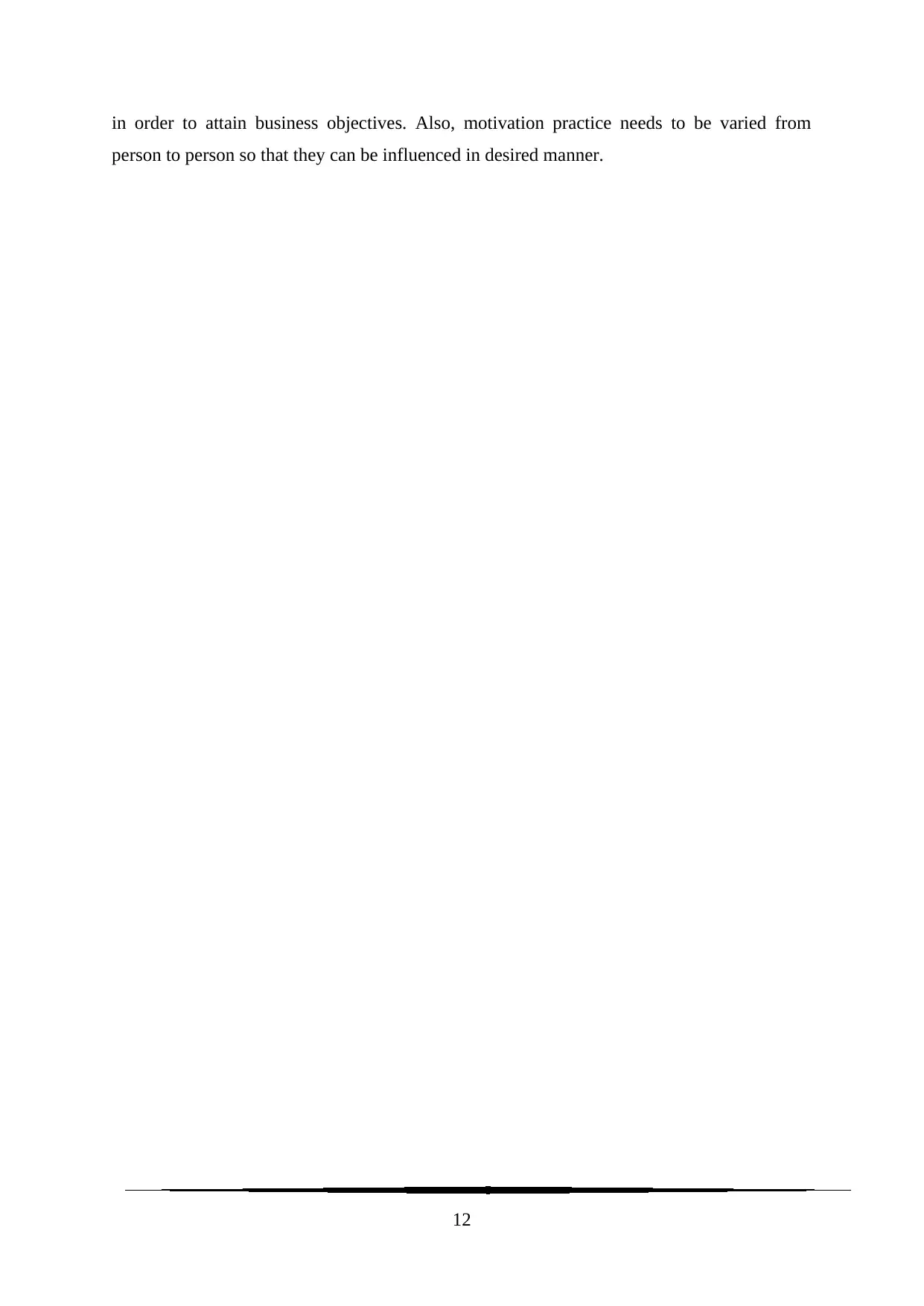
in order to attain business objectives. Also, motivation practice needs to be varied from
person to person so that they can be influenced in desired manner.
12
person to person so that they can be influenced in desired manner.
12
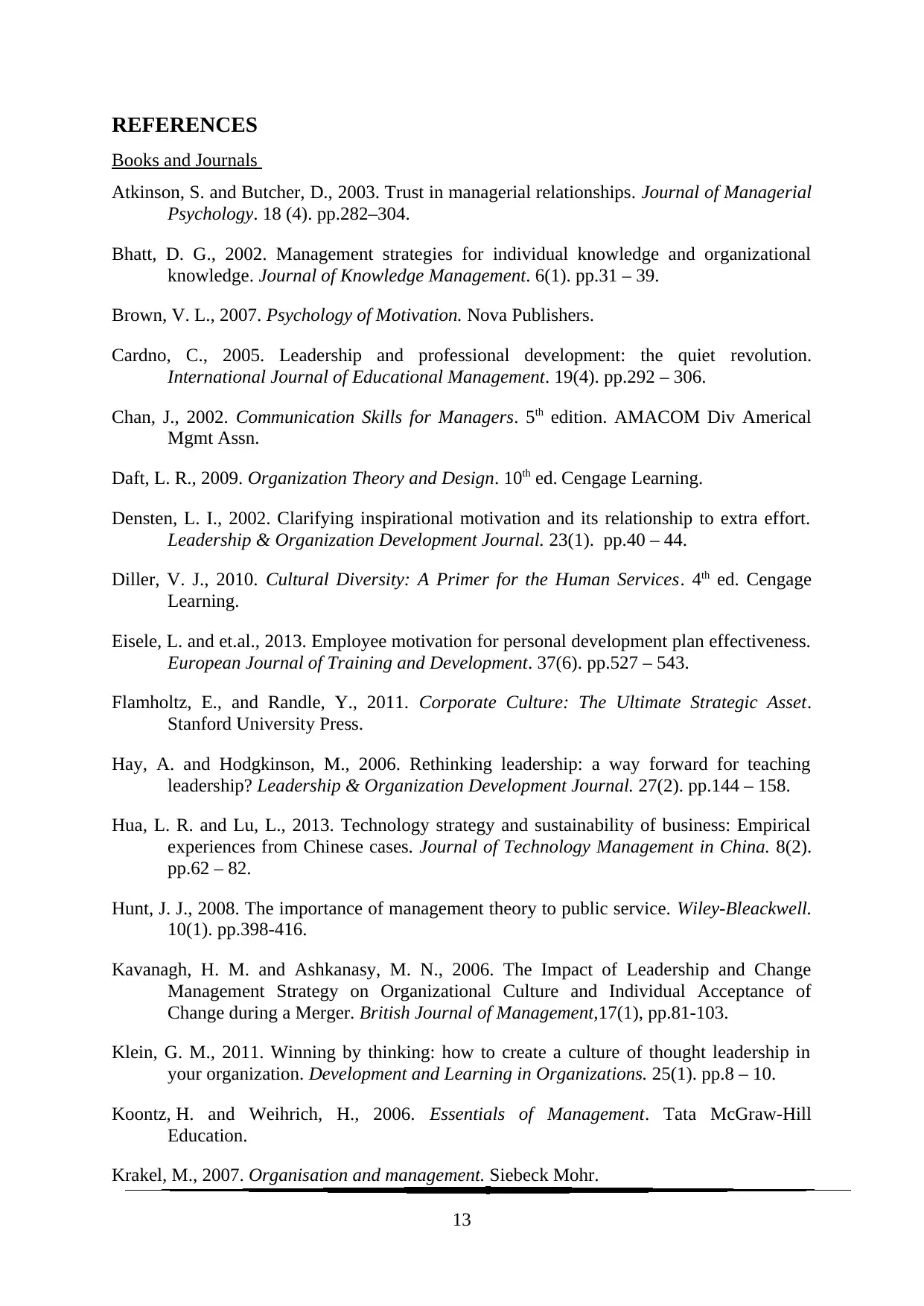
REFERENCES
Books and Journals
Atkinson, S. and Butcher, D., 2003. Trust in managerial relationships. Journal of Managerial
Psychology. 18 (4). pp.282–304.
Bhatt, D. G., 2002. Management strategies for individual knowledge and organizational
knowledge. Journal of Knowledge Management. 6(1). pp.31 – 39.
Brown, V. L., 2007. Psychology of Motivation. Nova Publishers.
Cardno, C., 2005. Leadership and professional development: the quiet revolution.
International Journal of Educational Management. 19(4). pp.292 – 306.
Chan, J., 2002. Communication Skills for Managers. 5th edition. AMACOM Div Americal
Mgmt Assn.
Daft, L. R., 2009. Organization Theory and Design. 10th ed. Cengage Learning.
Densten, L. I., 2002. Clarifying inspirational motivation and its relationship to extra effort.
Leadership & Organization Development Journal. 23(1). pp.40 – 44.
Diller, V. J., 2010. Cultural Diversity: A Primer for the Human Services. 4th ed. Cengage
Learning.
Eisele, L. and et.al., 2013. Employee motivation for personal development plan effectiveness.
European Journal of Training and Development. 37(6). pp.527 – 543.
Flamholtz, E., and Randle, Y., 2011. Corporate Culture: The Ultimate Strategic Asset.
Stanford University Press.
Hay, A. and Hodgkinson, M., 2006. Rethinking leadership: a way forward for teaching
leadership? Leadership & Organization Development Journal. 27(2). pp.144 – 158.
Hua, L. R. and Lu, L., 2013. Technology strategy and sustainability of business: Empirical
experiences from Chinese cases. Journal of Technology Management in China. 8(2).
pp.62 – 82.
Hunt, J. J., 2008. The importance of management theory to public service. Wiley-Bleackwell.
10(1). pp.398-416.
Kavanagh, H. M. and Ashkanasy, M. N., 2006. The Impact of Leadership and Change
Management Strategy on Organizational Culture and Individual Acceptance of
Change during a Merger. British Journal of Management,17(1), pp.81-103.
Klein, G. M., 2011. Winning by thinking: how to create a culture of thought leadership in
your organization. Development and Learning in Organizations. 25(1). pp.8 – 10.
Koontz, H. and Weihrich, H., 2006. Essentials of Management. Tata McGraw-Hill
Education.
Krakel, M., 2007. Organisation and management. Siebeck Mohr.
13
Books and Journals
Atkinson, S. and Butcher, D., 2003. Trust in managerial relationships. Journal of Managerial
Psychology. 18 (4). pp.282–304.
Bhatt, D. G., 2002. Management strategies for individual knowledge and organizational
knowledge. Journal of Knowledge Management. 6(1). pp.31 – 39.
Brown, V. L., 2007. Psychology of Motivation. Nova Publishers.
Cardno, C., 2005. Leadership and professional development: the quiet revolution.
International Journal of Educational Management. 19(4). pp.292 – 306.
Chan, J., 2002. Communication Skills for Managers. 5th edition. AMACOM Div Americal
Mgmt Assn.
Daft, L. R., 2009. Organization Theory and Design. 10th ed. Cengage Learning.
Densten, L. I., 2002. Clarifying inspirational motivation and its relationship to extra effort.
Leadership & Organization Development Journal. 23(1). pp.40 – 44.
Diller, V. J., 2010. Cultural Diversity: A Primer for the Human Services. 4th ed. Cengage
Learning.
Eisele, L. and et.al., 2013. Employee motivation for personal development plan effectiveness.
European Journal of Training and Development. 37(6). pp.527 – 543.
Flamholtz, E., and Randle, Y., 2011. Corporate Culture: The Ultimate Strategic Asset.
Stanford University Press.
Hay, A. and Hodgkinson, M., 2006. Rethinking leadership: a way forward for teaching
leadership? Leadership & Organization Development Journal. 27(2). pp.144 – 158.
Hua, L. R. and Lu, L., 2013. Technology strategy and sustainability of business: Empirical
experiences from Chinese cases. Journal of Technology Management in China. 8(2).
pp.62 – 82.
Hunt, J. J., 2008. The importance of management theory to public service. Wiley-Bleackwell.
10(1). pp.398-416.
Kavanagh, H. M. and Ashkanasy, M. N., 2006. The Impact of Leadership and Change
Management Strategy on Organizational Culture and Individual Acceptance of
Change during a Merger. British Journal of Management,17(1), pp.81-103.
Klein, G. M., 2011. Winning by thinking: how to create a culture of thought leadership in
your organization. Development and Learning in Organizations. 25(1). pp.8 – 10.
Koontz, H. and Weihrich, H., 2006. Essentials of Management. Tata McGraw-Hill
Education.
Krakel, M., 2007. Organisation and management. Siebeck Mohr.
13
Secure Best Marks with AI Grader
Need help grading? Try our AI Grader for instant feedback on your assignments.
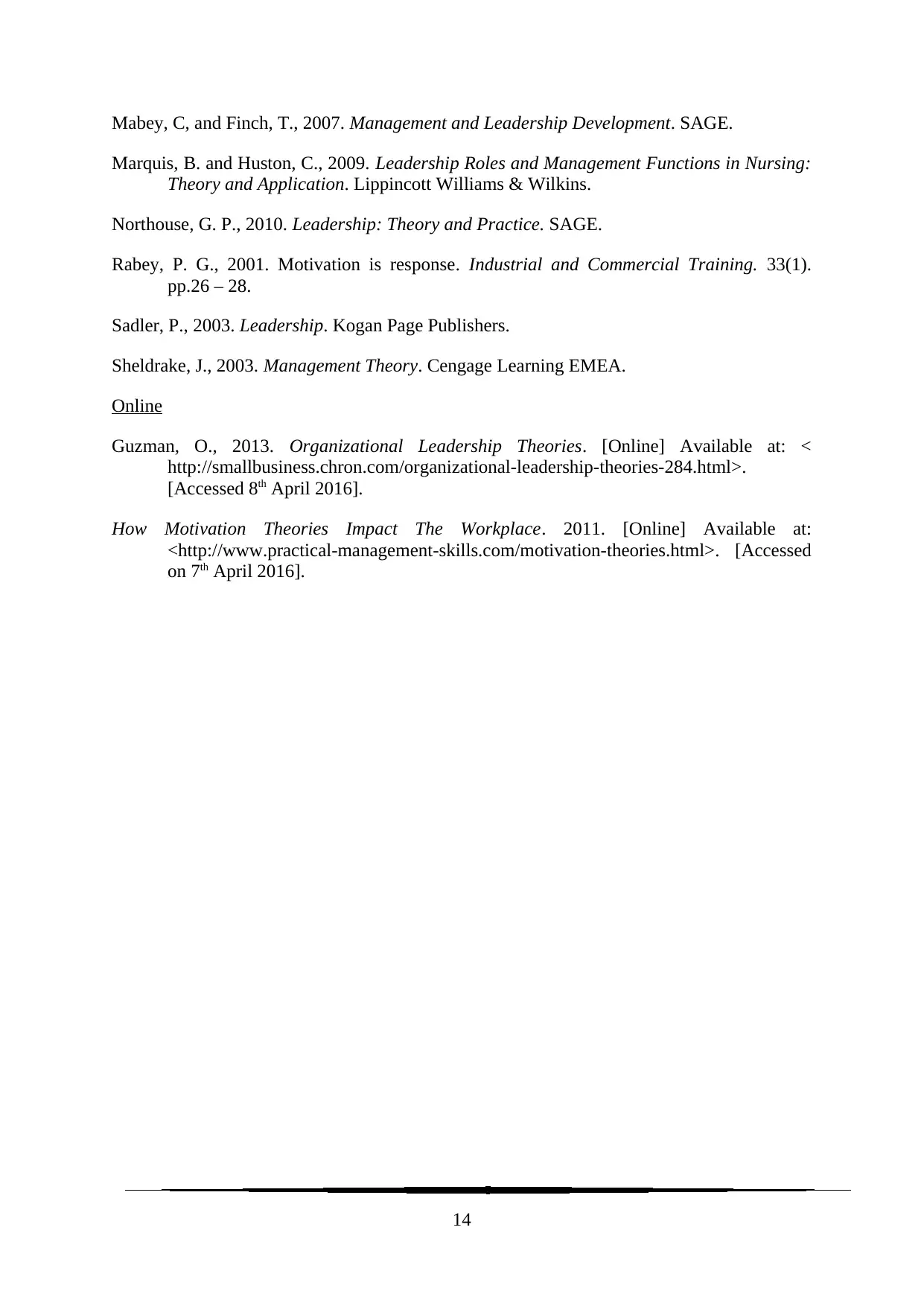
Mabey, C, and Finch, T., 2007. Management and Leadership Development. SAGE.
Marquis, B. and Huston, C., 2009. Leadership Roles and Management Functions in Nursing:
Theory and Application. Lippincott Williams & Wilkins.
Northouse, G. P., 2010. Leadership: Theory and Practice. SAGE.
Rabey, P. G., 2001. Motivation is response. Industrial and Commercial Training. 33(1).
pp.26 – 28.
Sadler, P., 2003. Leadership. Kogan Page Publishers.
Sheldrake, J., 2003. Management Theory. Cengage Learning EMEA.
Online
Guzman, O., 2013. Organizational Leadership Theories. [Online] Available at: <
http://smallbusiness.chron.com/organizational-leadership-theories-284.html>.
[Accessed 8th April 2016].
How Motivation Theories Impact The Workplace. 2011. [Online] Available at:
<http://www.practical-management-skills.com/motivation-theories.html>. [Accessed
on 7th April 2016].
14
Marquis, B. and Huston, C., 2009. Leadership Roles and Management Functions in Nursing:
Theory and Application. Lippincott Williams & Wilkins.
Northouse, G. P., 2010. Leadership: Theory and Practice. SAGE.
Rabey, P. G., 2001. Motivation is response. Industrial and Commercial Training. 33(1).
pp.26 – 28.
Sadler, P., 2003. Leadership. Kogan Page Publishers.
Sheldrake, J., 2003. Management Theory. Cengage Learning EMEA.
Online
Guzman, O., 2013. Organizational Leadership Theories. [Online] Available at: <
http://smallbusiness.chron.com/organizational-leadership-theories-284.html>.
[Accessed 8th April 2016].
How Motivation Theories Impact The Workplace. 2011. [Online] Available at:
<http://www.practical-management-skills.com/motivation-theories.html>. [Accessed
on 7th April 2016].
14
1 out of 17
Related Documents
Your All-in-One AI-Powered Toolkit for Academic Success.
+13062052269
info@desklib.com
Available 24*7 on WhatsApp / Email
![[object Object]](/_next/static/media/star-bottom.7253800d.svg)
Unlock your academic potential
© 2024 | Zucol Services PVT LTD | All rights reserved.





